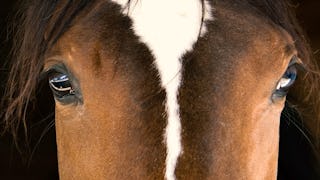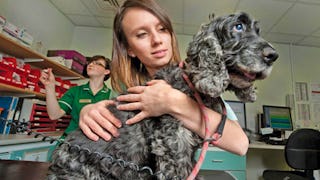Why is the experience of going to the vets a negative one for some animals? Is it the anticipated pain, the way the place smells, the colour of the waiting room, the noises coming from the consulting room, or something else?


(39 avis)
Expérience recommandée
Ce que vous apprendrez
Describe the theories and concepts of animal welfare and animal behaviour.
Explore different animal welfare approaches, techniques, and skills in different clinical areas.
Investigate how to implement good animal welfare practice in a clinical setting in relation to specific species.
Compétences que vous acquerrez
- Catégorie : Pain Management
- Catégorie : Long Term Care
- Catégorie : Anesthesiology
- Catégorie : Behavioral Health
- Catégorie : Patient Positioning
- Catégorie : Patient Observation
- Catégorie : Stress Management
- Catégorie : Behavior Management
- Catégorie : Preventative Care
- Catégorie : Patient Education And Counseling
- Catégorie : Clinical Practices
- Catégorie : Post-Anesthesia Care Unit
- Catégorie : Clinical Nutrition
- Catégorie : Pre-Anesthetic Assessment
- Catégorie : Operating Room (OR)
- Catégorie : Perioperative Care
Détails à connaître

Ajouter à votre profil LinkedIn
5 devoirs
Découvrez comment les employés des entreprises prestigieuses maîtrisent des compétences recherchées

Il y a 4 modules dans ce cours
In this first week, we look at animal welfare as a science, how we can use evidence to make objective measures to determine whether an animal is experiencing positive or negative welfare, and why it is so important in the veterinary clinic. We’ll also look at what constitutes normal cat, dog, and rabbit behaviour, what motivates canine aggression and what we can do if an owner reports aggressive behaviour in their dog.
Inclus
17 vidéos4 lectures2 devoirs4 sujets de discussion
This week we are examining what owners can do to help their animal companions better cope in the clinic BEFORE they arrive, what clinic staff can do to help reduce anxiety for the pet once they have entered the building, and we will define the terms ‘trigger stacking’ and ‘building a welfare bank account’. How to improve patient welfare and reduce stress in the waiting room and consulting room will also be explored this week by examining the latest scientific evidence, and we will also discuss the techniques and benefits of low stress handling, how to perform a low stress examination on a cat, dog, and rabbit, and how to handle a cat or dog that is behaving aggressively.
Inclus
14 vidéos2 lectures1 devoir3 sujets de discussion
This week we are going to delve into what we can do to make the preparation room, also known as the treatment room, less worrying for our patients. We will discuss pre-emptive, multi-modal analgesia prior to going for surgery, and the difference between light anaesthesia and nociception. We’ll also consider what we can do to make the operating room, and the kennels or recovery area more welfare focussed, and the ways in which we can improve the clinic experience for the long-term inpatient.
Inclus
8 vidéos3 lectures1 devoir3 sujets de discussion
This week we are talking about pain in rabbits, cats and dogs – how to recognise it, how to score it, how to treat it, and why, physiologically, treating acute pain is so vital. We’ll also study pain pathways, multimodal analgesia, the post operative advice we can give to owners to ensure good welfare continues when they take their animal home, and what owners can do to enrich the lives of their pets if they must be strictly rested for an extended period of time.
Inclus
14 vidéos4 lectures1 devoir4 sujets de discussion
Instructeurs

Offert par
En savoir plus sur Animal Health

The University of Edinburgh
 Statut : Prévisualisation
Statut : PrévisualisationThe University of Edinburgh
 Statut : Prévisualisation
Statut : PrévisualisationUniversity of California, Davis

The University of Edinburgh
Pour quelles raisons les étudiants sur Coursera nous choisissent-ils pour leur carrière ?




Avis des étudiants
39 avis
- 5 stars
97,43 %
- 4 stars
2,56 %
- 3 stars
0 %
- 2 stars
0 %
- 1 star
0 %
Affichage de 3 sur 39
Révisé le 25 juil. 2024
Simply amazing, very complete, very clear explanations,absolutely excellent. Highly recommended, all vets that love their patients and want their clinics to be extraordinary should take this course!
Révisé le 23 août 2024
Learned a lot about animal behavior in clinics! Overall loved the course!
Révisé le 2 janv. 2025
This course was great - interesting, with lots of practical advice. Would recommend to anyone working in veterinary practice.

Ouvrez de nouvelles portes avec Coursera Plus
Accès illimité à 10,000+ cours de niveau international, projets pratiques et programmes de certification prêts à l'emploi - tous inclus dans votre abonnement.
Faites progresser votre carrière avec un diplôme en ligne
Obtenez un diplôme auprès d’universités de renommée mondiale - 100 % en ligne
Rejoignez plus de 3 400 entreprises mondiales qui ont choisi Coursera pour les affaires
Améliorez les compétences de vos employés pour exceller dans l’économie numérique
Foire Aux Questions
To access the course materials, assignments and to earn a Certificate, you will need to purchase the Certificate experience when you enroll in a course. You can try a Free Trial instead, or apply for Financial Aid. The course may offer 'Full Course, No Certificate' instead. This option lets you see all course materials, submit required assessments, and get a final grade. This also means that you will not be able to purchase a Certificate experience.
When you purchase a Certificate you get access to all course materials, including graded assignments. Upon completing the course, your electronic Certificate will be added to your Accomplishments page - from there, you can print your Certificate or add it to your LinkedIn profile.
Yes. In select learning programs, you can apply for financial aid or a scholarship if you can’t afford the enrollment fee. If fin aid or scholarship is available for your learning program selection, you’ll find a link to apply on the description page.
Plus de questions
Aide financière disponible,


